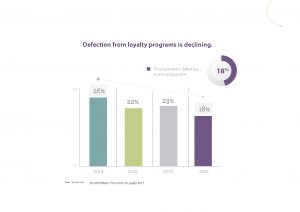The latest for love or money 2017 research report continued to identify elements of loyalty program success and how to make them more profitable to a business and more meaningful to members.
The 2017 research study measured loyalty program interaction based on:
- Defection from programs – members leaving a program passively and actively
- Program engagement – members taking advantage of benefits they have earned
Defection from program is declining
Over the 4 years this research has been implemented, there has been a decline in defection based on members actively leaving their programs (requesting to be removed) and passively leaving (simply stopped interacting).
- The 2017 research identified defection at 18% the lowest since 2013.

Enjoying the benefits earned from programs is increasing
Another indication of program interaction is when members actually redeem and enjoy the benefits they have earned from engaging with a program.
- In 2017, 64% of members enjoyed the benefits of the rewards they earned, up from 54% in 2016. Millennials are even more engaged with 68% indicating that they enjoyed benefits they earned from their membership of programs.

Benchmarks vs your program metrics
With these two metrics of program engagement (there are others) in mind, how does your program’s metrics measure vs those identified in for love or money 2017
- Is your defection rate measure less than 18%?
- Is your benefit redemption rate more than 64%?
To find out more about these insights and many more, download a complimentary copy of the Executive Summary of for love or money 2017 or for a deeper understanding of all the benchmark results and insights across demographics and generational cohorts, you can purchase the full 100+ page report.


